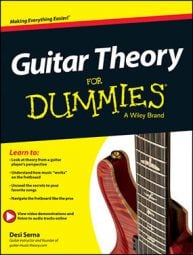Every piece of music on the guitar has a tonal center called a tonic. The tonic is the primary pitch or chord that everything else revolves around. It’s where a piece of music sounds resolved or complete and usually where the music begins and ends.
Generally speaking, the tonic also determines a song’s key. There are two basic types of music tonalities and keys: major and minor. If a piece of music centers on a major chord, then it’s considered to be in a major key. If music centers on a minor chord, it’s a minor key. For instance, if a song centers on a G chord, you say it’s in the key of G.
Traditionally, music has been taught as being in either the major or minor scale. The good news is if you know the major scale, then you also know the minor scale. The minor scale is drawn from the 6th degree of the major scale. Start any major scale on its 6th degree and you have a minor scale.
For example, the 6th degree in the G major scale is E. The E minor scale is simply the notes of G major starting on E, as you see here:
G major scale
1-2-3-4-5-6-7
G-A-B-C-D-E-Fs
E minor scale
1-2-3-4-5-6-7
E-Fs-G-A-B-C-D
The relationship between the major and minor scales (and between the 1st and 6th chords) is often described as being relative. For example, in the key of G, I and vi are G and Em. G major is the relative major of E minor, and E minor is the relative minor of G major. This relative relationship holds true in all keys.
In the key of C, for example, the I chord is C major and the vi chord is A minor. They, too, are relative major and minor chords and scales. In written music, relative major and minor keys actually share the same key signature.
Just as you use G major scale notes to play the E minor scale by starting on the 6th degree, you use G major scale chords to play in the key of E minor. The following list shows the chords for both the G major scale and its relative minor, E minor. Notice how the E minor scale features the very same chords, starting on the 6th degree:
G major
1-2-3-4-5-6-7
G-Am-Bm-C-D-Em-Fsmf5
E minor
1-2-3-4-5-6-7
Em-Fsmf5-G-Am-Bm-C-D
The major scale chords are represented with Roman numerals that look like this:
I-ii-iii-IV-V-vi-viif5
Rearrange the major scale with the 6th degree in the first position and you get this sequence:
vi-viif5-I-ii-iii-IV-V

